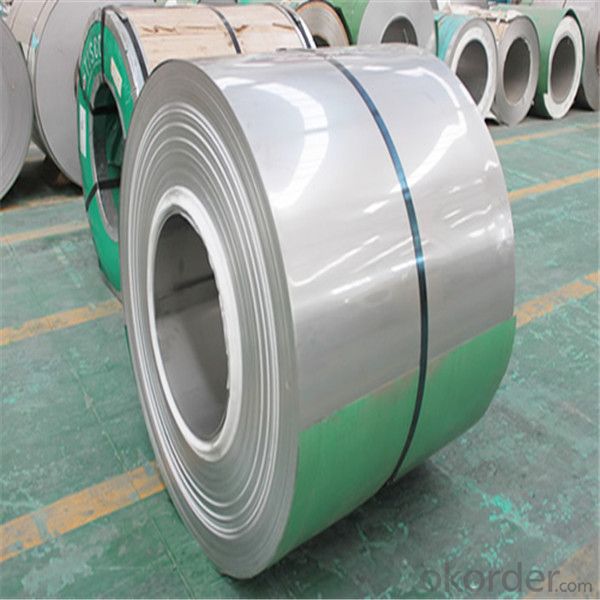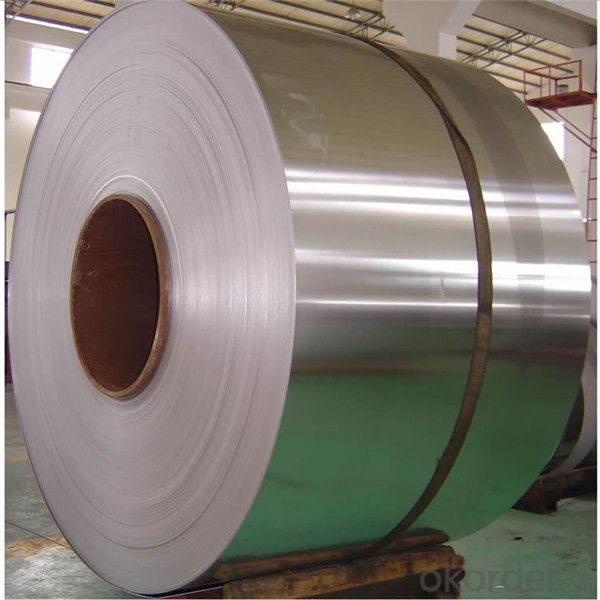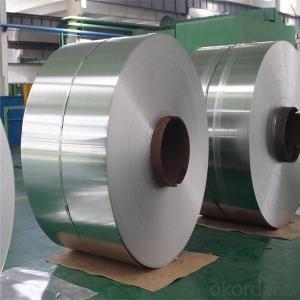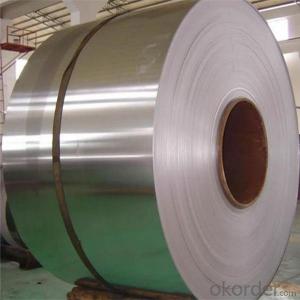SUS 321 Stainless Steel Coil on Stock Hot Rolled
- Loading Port:
- Shanghai
- Payment Terms:
- TT OR LC
- Min Order Qty:
- 2 m.t.
- Supply Capability:
- 100000 m.t./month
OKorder Service Pledge
OKorder Financial Service
You Might Also Like
Item specifice
Hot Rolled SUS 321 Stainless Steel Coil on Stock
Product Description
Specifications:
All Materials: 321
Thickness: 0.3-10mm
Width: 500-2000mm
Length: 1-6m or customized
Surface: 2B finished , slit edge
Picture show:


Applications:
Stainless Steel is widely used in Kitchenware, cutlery, household hardware, surgical instruments, major appliances, industrial equipment and as an automotive and aerospace structural alloy and construction material in large buildings. Storage tanks and tanker used to transport orange juice and other food are often made of stainless steel, because of its corrosion resistance and antibacterial properties. This also influences its use in commercial kitchens and food processing plants, as it can be steam-cleaned and sterilized and does not need paint or other surface finishes.
More Details:
Product name | Hot Rolled SUS 321 Stainless Steel Coil on Stock |
Standard | ASTM AISI JIS DIN EN SUS |
Place of Origin | Jiangsu of China (Mainland) |
Brand Name | TISCO |
Type | Coil |
Certification | ISO Certificate, Mill Test Certificate |
Application | Kitchenware, Tanks, Food Processing, cutlery, construction, household hardware, surgical instruments, major appliances, industrial equipment and as an automotive and aerospace structural alloy |
Technical treatment | Cold Rolled, Hot Rolled |
MOQ | 1 Metric Ton |
Terms of delivery | FOB, CFR, CIF |
Terms of Payment | L/C, T/T (30% desipot) |
Port of Loading | Shanghai or any port of China |
Packing | In bundles, packed with Water proof paper and wooden pallet. To be packed strongly avoid damage during transportation, and can be also according to the regulations and customer’s requests. Furthermore, products packages also are tagged clear on the outside for easy identification of the product and quality information. |
Time of delivery | Normally delivery within 7-10 days after recieve your 30% desipot or as your requirement |
Stock | Ready In stocks |
Packaging & Shipping
Packing info.
Standard export seaworthy packing (with waterproof paper, metal belt pack sheet,
then put them in wooden pallet, then put in container) or customized.
Products are packed and labeled according to the regulations and customer's request.
Grate car is taken to avoid any damage which might otherwise be caused during storage
or transportation. In addition, clear labels are tagged on the outside of the packages
for easy identification of the product I.D. and quality information.
20 ft - GP: 5.8m (Length) * 2.13m (Width) * 2.18m (Hight) ------ About 23MTS
40 ft - GP: 11.8m (Length) * 2.13m (Width) * 2.18m (Hight) ------ About 27MTS
40 ft - HG: 11.8m (Length) * 2.13m (Width) * 2.72m (Hight) ------ About 27MTS
Terms:
1) Delivery term: About 7-10 days after receiving the 30% deposit, or as soon aswe receive the repayment, we can arrange shipment right now.
2) Payment term: T/T, including the 30% deposit after signing the contract and the balance 70% after sending the B/L copy.
3) Quality assurance: Mill Test Certificate or the material certificate will be supplier
Our Services
Service
1) Transportation speed is quick
2) High quality , quantity is with preferential treatment
3) We can cut stainless steel sheet in any shapes
4) Famous stainless steel company in China and overseas.
5) Strong ability to supply
6) Branded stainless steel
7) More than 200 patterns
8) Bottom price
9) Reliable quality and service
10) Buyer's specifications accepted
11) Experienced R & D Department
FAQ
FAQ
Q:What kind of work does your company do?
A:Our company is a professional manufacturer.We mainly produces forged rollers,forged shafts,round bars,
casting iron pipe mould and various types of forging pieces fully in accordance with customers' requirement.
Q:What are the advantages of your company?
A: We have many professional technical personnel.And we have more competitive prices and better after-sales service than trading companies.
Q:How do you control the quality?
A:Our company is certificated to ISO9001:2008.We have many inspectors and every product will have been tested for 4-5 processes.
We welcome customers or the third party inspection agencies to come to our factory for inspection.
Q:What about your price?
A:Our price is very competitive because we are a factory.Please contact us if you are interested in our products.
Q:How long is your delivery time?
A:Different products have different delivery time.The products will be delivered as soon as possible on the basis
of the quality assurance.Usually the delivery time is within 7-10 days after we recieved your desipot.
- Q:Are stainless steel strips suitable for chemical pipes?
- Yes, stainless steel strips are suitable for chemical pipes. Stainless steel is highly resistant to corrosion, making it an ideal material for piping systems that handle chemicals. It has excellent resistance to a wide range of chemicals, including acids, alkalis, and solvents. Stainless steel's resistance to corrosion is due to the presence of chromium, which forms a protective oxide layer on the surface of the metal, preventing further corrosion and ensuring the longevity of the pipes. Additionally, stainless steel is known for its high strength and durability, making it capable of withstanding the high pressures and temperatures often associated with chemical processing. Overall, stainless steel strips are a reliable and suitable choice for chemical pipes.
- Q:Can stainless steel strips be used in marine applications?
- Indeed, the utilization of stainless steel strips in marine applications is possible. The exceptional corrosion resistance of stainless steel renders it a perfect choice for marine settings, where it endures constant exposure to saltwater and moisture. In marine applications, such as boat hardware, marine fittings, and structural components, stainless steel strips are frequently employed. These strips are specifically engineered to endure the rigorous conditions of the sea, including elevated levels of salt, humidity, and UV exposure. Moreover, stainless steel strips exhibit remarkable strength and durability, guaranteeing their ability to endure the challenging conditions of marine environments for an extended duration.
- Q:How do stainless steel strips handle exposure to solvents?
- Stainless steel strips are known for their excellent resistance to solvents. They are highly durable and can withstand exposure to various solvents without significant damage or corrosion. The composition of stainless steel, which includes a high percentage of chromium, provides a protective layer called chromium oxide. This layer acts as a shield against solvents, preventing them from penetrating the steel surface and causing any adverse effects. Furthermore, stainless steel strips have low reactivity with solvents, making them suitable for use in environments where exposure to chemicals is common. They are resistant to many organic solvents, such as alcohols, acetone, and hydrocarbons, as well as some inorganic solvents like acids and bases. It is important to note that while stainless steel strips generally have excellent resistance to solvents, their performance may vary depending on the specific type and concentration of the solvent, as well as the duration of exposure. In some cases, prolonged exposure to aggressive solvents or high concentrations may lead to slight discoloration or etching on the stainless steel surface. To ensure optimal performance and longevity, it is recommended to choose the appropriate grade of stainless steel for specific solvent applications. Consulting with stainless steel manufacturers or industry experts can provide valuable guidance on selecting the most suitable stainless steel grade for a particular solvent environment. Regular cleaning and maintenance, including wiping off any spilled solvents and avoiding abrasive cleaning agents, can also help preserve the integrity and appearance of stainless steel strips exposed to solvents.
- Q:Can stainless steel strips be used in nuclear power applications?
- Yes, stainless steel strips can be used in nuclear power applications. Stainless steel is a preferred material in the nuclear industry due to its excellent resistance to corrosion, high-temperature strength, and low magnetic permeability. It is commonly used for a range of applications including reactor components, fuel storage containers, heat exchangers, and piping systems. Stainless steel strips offer the advantage of being easily formed into various shapes and sizes, making them suitable for different nuclear power applications. Additionally, stainless steel's ability to withstand radiation damage and its minimal interaction with nuclear fuel further contribute to its suitability in nuclear power applications.
- Q:What are the different types of surface treatments for stainless steel strips?
- Stainless steel strips can be treated in various ways to achieve different results and benefits. Let's explore the different options available: 1. Pickling: By immersing stainless steel strips in an acid solution like nitric or hydrochloric acid, pickling eliminates impurities and contaminants, leaving behind a clean and smooth surface finish. 2. Passivation: This method involves creating a protective oxide layer on the surface of stainless steel strips, enhancing their resistance against corrosion. This can be done by immersing the strips in a nitric acid solution or applying a citric acid paste. 3. Electropolishing: Through an electrochemical process, electropolishing removes a thin layer of material from stainless steel strips, resulting in a shiny and smooth surface finish. Not only does it enhance the appearance, but it also improves corrosion resistance and cleanability. 4. Brushing: Abrasive materials like wire brushes or abrasive pads are used in brushing to create a brushed or satin finish on stainless steel strips. This treatment helps conceal surface imperfections and provides a uniform and decorative appearance. 5. Grinding: Mechanical grinding involves using abrasive wheels or belts to remove material from the surface of stainless steel strips. This treatment can achieve a specific surface roughness or eliminate any defects or blemishes. 6. Coating: Adding a protective material, such as paint or powder coating, to the surface of stainless steel strips enhances corrosion resistance and improves the aesthetic appearance. Coatings are available in a wide range of colors and finishes. 7. Polishing: By using abrasive materials like polishing compounds or buffing wheels, polishing creates a mirror-like finish on stainless steel strips. This treatment enhances appearance and can also improve corrosion resistance. Each of these surface treatments offers unique advantages depending on the desired outcome and application requirements. It is crucial to consider factors such as corrosion resistance, aesthetics, and functionality when selecting the appropriate treatment for stainless steel strips.
- Q:What is the typical price range for 111 stainless steel strips?
- The typical price range for 111 stainless steel strips can vary depending on factors such as the quantity, quality, and supplier. However, a rough estimate for the price range could be anywhere from $1 to $5 per strip.
- Q:Are 111 stainless steel strips suitable for food processing equipment?
- Food processing equipment can benefit from the use of 111 stainless steel strips, as they possess excellent corrosion resistance, strength, and hygienic properties. The widely utilized stainless steel material is known for its versatility in the food industry. Grade 304 stainless steel, also referred to as the 111 stainless steel grade, is particularly popular in food processing equipment due to its outstanding resistance to corrosion caused by acids, alkalis, and other chemicals commonly found in food processing environments. Another advantage is that Grade 304 stainless steel is non-porous, making it effortless to maintain high levels of hygiene by ensuring easy cleaning. Therefore, opting for 111 stainless steel strips would be a suitable decision for food processing equipment.
- Q:What is the corrosion resistance of stainless steel strips in different environments?
- Stainless steel strips have excellent corrosion resistance in a wide range of environments. This is due to the presence of a protective layer called chromium oxide on the surface of the steel. The chromium oxide layer forms naturally when the steel is exposed to oxygen, creating a passive barrier that prevents further corrosion. In general, stainless steel strips exhibit high resistance to corrosion in atmospheric conditions, making them suitable for outdoor applications. They can withstand exposure to moisture, rain, and even saltwater without significant degradation. This makes stainless steel an ideal choice for marine environments or coastal areas where corrosion is a common concern. Stainless steel strips also have exceptional resistance to many chemicals and acids. They can withstand exposure to various organic and inorganic compounds, making them suitable for use in chemical processing plants, pharmaceutical industries, and other corrosive environments. However, it is important to note that certain concentrations or combinations of chemicals can still cause corrosion in stainless steel, so it is essential to select the appropriate grade of stainless steel for specific applications. The corrosion resistance of stainless steel strips can vary depending on the specific alloy and surface finish. For instance, austenitic stainless steels, such as grades 304 and 316, offer excellent resistance to corrosion in most environments, including acidic and alkaline conditions. Ferritic and martensitic stainless steels, on the other hand, may have lower corrosion resistance but can still perform well in many non-corrosive or mildly corrosive environments. In summary, stainless steel strips possess remarkable corrosion resistance in a wide range of environments. Their ability to resist corrosion makes them highly versatile and suitable for various applications, including construction, automotive, food processing, and many others. However, it is important to consider the specific conditions and requirements of the environment when selecting the appropriate grade and finish of stainless steel for optimal corrosion resistance.
- Q:How do stainless steel strips perform in high temperature environments?
- Stainless steel strips are renowned for their exceptional performance in environments with high temperatures. Their outstanding resistance to oxidation and scaling at elevated temperatures is a result of their inherent properties. This can be mainly attributed to the presence of chromium in the steel, which creates a protective oxide layer on the surface when exposed to air, thereby preventing further corrosion. In high temperature environments, stainless steel strips maintain their strength and integrity, rendering them suitable for a wide array of applications. They can endure thermal cycling without significant degradation, ensuring long-term performance and dependability. Furthermore, stainless steel strips exhibit favorable mechanical properties at elevated temperatures, including high tensile and creep strength. This makes them highly desirable for applications involving both high temperatures and mechanical stresses, such as in heat exchangers, furnaces, and automotive components. Moreover, stainless steel strips possess exceptional thermal conductivity, enabling efficient heat transfer and distribution. This is particularly crucial in high temperature environments, as it aids in maintaining consistent temperatures and preventing the occurrence of hot spots or thermal stress. Overall, stainless steel strips have consistently demonstrated their reliability and durability in high temperature environments. Their resistance to corrosion, mechanical strength, and thermal conductivity make them a popular choice across a variety of industries, guaranteeing optimal performance and longevity even under extreme conditions.
- Q:Are stainless steel strips suitable for elevator doors?
- Yes, stainless steel strips are highly suitable for elevator doors. Stainless steel is a durable and corrosion-resistant material, making it ideal for withstanding the wear and tear of daily elevator usage. Additionally, its sleek and modern appearance adds an aesthetic appeal to the elevator doors.
1. Manufacturer Overview |
|
|---|---|
| Location | |
| Year Established | |
| Annual Output Value | |
| Main Markets | |
| Company Certifications | |
2. Manufacturer Certificates |
|
|---|---|
| a) Certification Name | |
| Range | |
| Reference | |
| Validity Period | |
3. Manufacturer Capability |
|
|---|---|
| a)Trade Capacity | |
| Nearest Port | |
| Export Percentage | |
| No.of Employees in Trade Department | |
| Language Spoken: | |
| b)Factory Information | |
| Factory Size: | |
| No. of Production Lines | |
| Contract Manufacturing | |
| Product Price Range | |
Send your message to us
SUS 321 Stainless Steel Coil on Stock Hot Rolled
- Loading Port:
- Shanghai
- Payment Terms:
- TT OR LC
- Min Order Qty:
- 2 m.t.
- Supply Capability:
- 100000 m.t./month
OKorder Service Pledge
OKorder Financial Service
Similar products
New products
Hot products
Hot Searches
Related keywords



























